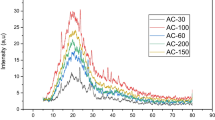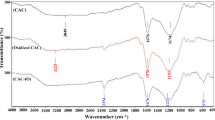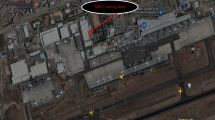Abstract
Hexavalent chromium (Cr(VI)) is the most hazardous and toxic oxidation state of chromium and for this reason, its effective removal from water below the drinking water limits is a major issue. Adsorption is a very promising technology, among several techniques, and activated carbon is a common adsorbent material, used for water treatment, due to its extensive surface area and porosity. In the last years, emerging composite adsorbents containing two or more metal oxides have gained significant attention. However, there are few publications related to the application of modified activated carbon with a combination of iron and manganese or copper oxides, to remove Cr(VI) from water, which is why these materials are the focus of this research. The effect of pH value, contact time, and initial Cr(VI) concentration was examined with respect to Cr(VI) removal. The results indicated that the maximum Cr(VI) removal was observed at pH 3 with 3 h contact time. The most effective adsorbent was the NFM material (Fe–Mn modified carbon) where a substantial quantitative removal of Cr(VI) (99.7%) was observed. Langmuir isotherm and pseudo-second order kinetic models fitted the experimental data sufficiently. The maximum adsorption capacity for NFM found was 44.42 mg/g by using the Langmuir model. Finally, the structure of the formed modified adsorbents materials was studied by the application of BET and SEM characterization techniques.









Similar content being viewed by others
Data Availability
The datasets generated during and/or analyzed during the current study are available from the corresponding author on reasonable request.
References
Abuzalat, O., Wong, D., & Elsayed, M. A. (2022). Nano-porous composites of activated carbon–metal organic frameworks (Fe-BDC@AC) for rapid removal of Cr (VI): Synthesis, adsorption, mechanism, and kinetics studies. Journal of Inorganic and Organometallic Polymers and Materials. https://doi.org/10.1007/s10904-022-02237-9
APHA (1981) Standard methods for the examination of water and wastewater. American Public Health Association.
Asimakopoulos, G., Karakassides, A., Baikousi, M., Gioti, C., Moschovas, D., Avgeropoulos, A., Bourlinos, A. B., Douvalis, A. P., Salmas, C. E., & Karakassides, M. A. (2021). Nanoporous carbon magnetic hybrid derived from waterlock polymers and its application for hexavalent chromium removal from aqueous solution. C, 7, 69. https://doi.org/10.3390/c7040069
Baccar, R., Bouzid, J., Feki, M., & Montiel, A. (2009). Preparation of activated carbon from Tunisian olive-waste cakes and its application for adsorption of heavy metal ions. Journal of Hazardous Materials, 162, 1522–1529. https://doi.org/10.1016/j.jhazmat.2008.06.041
Beksissa, R., Tekola, B., Ayala, T., & Dame, B. (2021). Investigation of the adsorption performance of acid treated lignite coal for Cr (VI) removal from aqueous solution. Environmental Challenges, 4, 100091. https://doi.org/10.1016/j.envc.2021.100091
Bessaies, H., Iftekhar, S., Asif, M. B., et al. (2021). Characterization and physicochemical aspects of novel cellulose-based layered double hydroxide nanocomposite for removal of antimony and fluoride from aqueous solution. Journal of Environmental Sciences (china), 102, 301–315. https://doi.org/10.1016/j.jes.2020.09.034
Boussouga, Y. A., Richards, B. S., & Schäfer, A. I. (2021). Renewable energy powered membrane technology: System resilience under solar irradiance fluctuations during the treatment of fluoride-rich natural waters by different nanofiltration/reverse osmosis membranes. Journal of Membrane Science, 617, 118452. https://doi.org/10.1016/j.memsci.2020.118452
Deng, Z. L., Liang, M. N., Li, H. H., & Zhu, Z. J. (2016). Advances in preparation of modified activated carbon and its applications in the removal of chromium (VI) from aqueous solutions. IOP Conference Series: Earth and Environmental Science, 39, 012065. https://doi.org/10.1088/1755-1315/39/1/012065
Desta, M. B. (2013). Batch sorption experiments: Langmuir and freundlich isotherm studies for the adsorption of textile metal ions onto teff straw (eragrostis tef) agricultural waste. Journal of Thermodynamics, 1. https://doi.org/10.1155/2013/375830
Dula, T., Siraj, K., & Kitte, S. A. (2014). Adsorption of hexavalent chromium from aqueous solution using chemically activated carbon prepared from locally available waste of bamboo ( Oxytenanthera abyssinica ). ISRN Environ Chem, 2014, 1–9. https://doi.org/10.1155/2014/438245
Emamy, F. H., Bumajdad, A., & Lukaszewicz, J. P. (2021). Adsorption of hexavalent chromium and divalent lead ions on the nitrogen-enriched chitosan-based activated carbon. Nanomaterials, 11, 1907. https://doi.org/10.3390/nano11081907
EPA, U., (1973). Chromium compounds: Hazard summary (pp. 639–700). National Center for Environmental Assessment, Office of Research & Development.
Fahim, N. F., Barsoum, B. N., Eid, A. E., & Khalil, M. S. (2006). Removal of chromium(III) from tannery wastewater using activated carbon from sugar industrial waste. Journal of Hazardous Materials, 136, 303–309. https://doi.org/10.1016/j.jhazmat.2005.12.014
Gallios, GP., Tolkou, A. K., Katsoyiannis, I. A., et al. (2017). Adsorption of arsenate by nano scaled activated carbon modified by iron and manganese oxides. Sustain 9.https://doi.org/10.3390/su9101684
Gorzin, F., & Bahri Rasht Abadi, M. M. (2018). Adsorption of Cr(VI) from aqueous solution by adsorbent prepared from paper mill sludge: Kinetics and thermodynamics studies. Adsorption Science & Technology, 36, 149–169. https://doi.org/10.1177/0263617416686976
Hamadi, N. K., Chen, X. D., Farid, M. M., & Lu, M. G. Q. (2001). Adsorption kinetics for the removal of chromium(VI) from aqueous solution by adsorbents derived from used tyres and sawdust. Chemical Engineering Journal, 84, 95–105. https://doi.org/10.1016/S1385-8947(01)00194-2
Hu, B., Wu, L., Ou, M., et al. (2021). Sorption studies of chromium(VI) onto cerium/ferroferric oxide composites. Journal of Inorganic and Organometallic Polymers and Materials, 31, 2627–2637. https://doi.org/10.1007/s10904-021-01944-z
Ince, M., & Ince, O. K. (2017). An overview of adsorption technique for heavy metal removal from water / wastewater : A critical review Su / Atıksuda Ağır Metal Giderimi için Adsorption Tekniğine Genel Bir Bakış : Önemli Bir İnceleme. Int J Pure Appl Sci Technol, 3, 10–19.
Jais, F. M., Ibrahim, S., Yoon, Y., & Jang, M. (2016). Enhanced arsenate removal by lanthanum and nano-magnetite composite incorporated palm shell waste-based activated carbon. Separation and Purification Technology, 169, 93–102. https://doi.org/10.1016/j.seppur.2016.05.034
Katsoyiannis, I. A., Gachet, C., & von Gunten, U. (2018). Fate of Cr(III) during ozonation of secondary municipal wastewater effluent. Ozone Science and Engineering, 40, 441–447. https://doi.org/10.1080/01919512.2018.1481362
Katsoyiannis, I. A., Xanthopoulou, M., & Zouboulis, A. I. (2020). Cr(VI) femoval from ground waters by ferrous iron redox-assisted coagulation in a continuous treatment unit comprising a plug flow pipe reactor and downflow sand filtration. Applied Sciences, 10, 802. https://doi.org/10.3390/app10030802
Kaur, R., Sharma, S., & Kaur, N. (2019). “Food security, nutrition and sustainable agriculture-emerging technologies” heavy metals toxicity and the environment. ~ 247 ~ Journal of Pharmacognosy and Phytochemistry, 1, 247–249.
Lalhmunsiama, T. D., & Lee, S. M. (2012). Activated carbon and manganese coated activated carbon precursor to dead biomass in the remediation of arsenic contaminated water. Environ Eng Res, 17, 41–48. https://doi.org/10.4491/eer.2012.17.S1.S41
Liu, P., Cai, W., Chen, J., et al. (2021). One-pot hydrothermal preparation of manganese-doped carbon microspheres for effective deep removal of hexavalent chromium from wastewater. Journal of Colloid and Interface Science, 599, 427–435. https://doi.org/10.1016/j.jcis.2021.04.098
Lu, W., Li, J., Sheng, Y., et al. (2017). One-pot synthesis of magnetic iron oxide nanoparticle-multiwalled carbon nanotube composites for enhanced removal of Cr(VI) from aqueous solution. Journal of Colloid and Interface Science, 505, 1134–1146. https://doi.org/10.1016/j.jcis.2017.07.013
Martinez-Vargas, D. R., Larios-Durán, E. R., Chazaro-Ruiz, L. F., & Rangel-Mendez, J. R. (2021). Correlation between physicochemical and electrochemical properties of an activated carbon doped with lanthanum for fluoride electrosorption. Separation and Purification Technology, 268, 118702. https://doi.org/10.1016/j.seppur.2021.118702
Meez, E., Tolkou, A. K., Giannakoudakis, D. A., Katsoyiannis, I. A., & Kyzas, G. Z. (2021). Activated carbons for arsenic removal from natural waters and wastewaters: A review. Water, 13, 2982. https://doi.org/10.3390/w13212982
Mishra, S. P., & Ghosh, M. R. (2020). Use of silver impregnated activated carbon (SAC) for Cr(VI) removal. Journal of Environmental Chemical Engineering, 8, 103641. https://doi.org/10.1016/j.jece.2019.103641
Mortazavian, S., An, H., Chun, D., & Moon, J. (2018). Activated carbon impregnated by zero-valent iron nanoparticles (AC/nZVI) optimized for simultaneous adsorption and reduction of aqueous hexavalent chromium: Material characterizations and kinetic studies. Chemical Engineering Journal, 353, 781–795. https://doi.org/10.1016/j.cej.2018.07.170
OMS (1996). Chromium in drinking-water. Background document for development of WHO Guidelines for drinking-water quality. World Health Organization; 2020 (WHO/HEP/ECH/WSH/2020.3). Licence: CC BY-NC-SA 3.0 IGO.
Pájaro, Y., & Diaz, F. (2012). Removal of hexavalent chromium from contaminated water. Revista Colombiana de Quimica, 41(2), 283–298.
Pandey, P. K., Sharma, S. K., & Sambi, S. S. (2010). Kinetics and equilibrium study of chromium adsorption on zeolitenax. International Journal of Environmental Science and Technology, 7, 395–404. https://doi.org/10.1007/BF03326149
Peternela, J., Silva, M. F., Vieira, M. F., Bergamasco, R., & Marquetotti Salcedo Vieira, A. (2018). Synthesis and impregnation of copper oxide nanoparticles on activated carbon through green synthesis for water pollutant removal. Materials Research, 21(1). https://doi.org/10.1590/1980-5373-mr-2016-0460
Rai, M. K., Shahi, G., Meena, V., et al. (2016). Removal of hexavalent chromium Cr (VI) using activated carbon prepared from mango kernel activated with H3PO4. Resour Technol, 2, S63–S70. https://doi.org/10.1016/j.reffit.2016.11.011
Samuel, M. S., Bhattacharya, J., Raj, S., et al. (2019). Efficient removal of Chromium(VI) from aqueous solution using chitosan grafted graphene oxide (CS-GO) nanocomposite. International Journal of Biological Macromolecules, 121, 285–292. https://doi.org/10.1016/j.ijbiomac.2018.09.170
Schäfer, A. I., Shen, J., & Richards, B. S. (2018). Renewable energy-powered membrane technology in Tanzanian communities. npj Clean Water, 1, 1–10. https://doi.org/10.1038/s41545-018-0026-6
Shu, J., Cheng, S., Xia, H., Zhang, L., Peng, J., Li, C., & Zhang, S. (2017). Copper loaded on activated carbon as an efficient adsorbent for removal of methylene blue. RSC Advances, 7, 14395–14405. https://doi.org/10.1039/c7ra00287d
Sultana, M., Rownok, M. H., Sabrin, M., et al. (2022). A review on experimental chemically modified activated carbon to enhance dye and heavy metals adsorption. Clean Eng Technol, 6, 100382. https://doi.org/10.1016/j.clet.2021.100382
Tolkou, A. K., Katsoyiannis, I. A., & Zouboulis, A. I. (2020). Removal of arsenic, chromium and uranium from water sources by novel nanostructured materials including graphene-based modified adsorbents: A mini review of recent developments. Applied Sciences, 10, 1–18. https://doi.org/10.3390/app10093241
Tolkou, A. K., Trikalioti, S., Makrogianni, O., et al. (2022). Lanthanum modified activated carbon from coconut shells for chromium ( VI ) removal from water. Nanomaterials, 12, 1–18.
Tolkou, A. K., & Zouboulis, A. I. (2020). Application of composite pre-polymerized coagulants for the treatment of high-strength industrial wastewaters. Water, 12, 1258. https://doi.org/10.3390/W12051258
Tumolo, M., Ancona, V., De Paola, D., et al. (2020). Chromium pollution in European water, sources, health risk, and remediation strategies: An overview. International Journal of Environmental Research and Public Health, 17, 1–25. https://doi.org/10.3390/ijerph17155438
Ventura-Houle, R., Font, X., & Heyer, L. (2018). Groundwater arsenic contamination and their variations on episode of drought: Ter River delta in Catalonia, Spain. Applied Water Science, 8, 1–8. https://doi.org/10.1007/s13201-018-0772-0
Wang, Q., Zhou, C., Kuang, Y.-J., et al. (2020). Removal of hexavalent chromium in aquatic solutions by pomelo peel. Water Science and Engineering, 13, 65–73. https://doi.org/10.1016/j.wse.2019.12.011
World Health Organization. (1970). European standards for drinking-water. American Journal of the Medical Sciences, 242, 56.
Yang, C., Ju, T., Wang, X., et al. (2020). The preparation of a novel iron/manganese binary oxide for the efficient removal of hexavalent chromium [Cr(vi)] from aqueous solutions. RSC Advances, 10, 10612–10623. https://doi.org/10.1039/c9ra10558a
Zhang, G., Ren, Z., Zhang, X., & Chen, J. (2013). Nanostructured iron(III)-copper(II) binary oxide: A novel adsorbent for enhanced arsenic removal from aqueous solutions. Water Research, 47, 4022–4031. https://doi.org/10.1016/j.watres.2012.11.059
Zhu, Y., Dai, W., Deng, K., et al. (2020). Efficient removal of Cr(VI) from aqueous solution by Fe-Mn oxide-modified biochar. Water Air, and Soil Pollution, 231. https://doi.org/10.1007/s11270-020-4432-2
Funding
Funding from the European Union’s H2020-MSCA-RISE-2016/under REA grant agreement No. 734641-NanoMed is greatly appreciated.
Author information
Authors and Affiliations
Contributions
All authors contributed to the study conception and design. Material preparation, data collection, and analysis were performed by Athanasia K. Tolkou, Miroslava Vaclavikova, and George P. Gallios. The first draft of the manuscript was written by Athanasia K. Tolkou and all authors commented on previous versions of the manuscript. All authors read and approved the final manuscript.
Corresponding author
Ethics declarations
Ethical Approval
Not applicable.
Consent to Participate
Not applicable.
Consent for Publication
We undertake and agree that the manuscript submitted to your journal has not been published elsewhere and has not been simultaneously submitted to other journals.
Competing Interests
The authors declare no competing interests.
Additional information
Publisher’s Note
Springer Nature remains neutral with regard to jurisdictional claims in published maps and institutional affiliations.
Rights and permissions
Springer Nature or its licensor holds exclusive rights to this article under a publishing agreement with the author(s) or other rightsholder(s); author self-archiving of the accepted manuscript version of this article is solely governed by the terms of such publishing agreement and applicable law.
About this article
Cite this article
Tolkou, A.K., Vaclavikova, M. & Gallios, G.P. Impregnated Activated Carbons with Binary Oxides of Iron-Manganese for Efficient Cr(VI) Removal from Water. Water Air Soil Pollut 233, 343 (2022). https://doi.org/10.1007/s11270-022-05826-z
Received:
Accepted:
Published:
DOI: https://doi.org/10.1007/s11270-022-05826-z




